You are here
Back to topHow to Suppress Surge Voltage?
For many circuits, the surge voltage will cause instability in the system, so the protection circuit is used to maintain the withstand capability of circuits. The international safety standard IEC 61000 specifies the immunity requirements for electronic products. IEC 61000-4-5, the part of IEC 61000, is for surges caused by over-voltages caused by momentary switch-on/off or lightning transients, and defined several test levels for suitability in different environments.
This article will discuss several ways to suppress surge voltage and compare its protection effectiveness.
1. Introduction
Surge is an instantaneous peak that exceeds the normal operating voltage, and occurs in overvoltage from switching、the transient of large loads、lightning strikes, and so on. In power-in process, the large current that charges the capacitor from the transient state to the steady state is the surge current, which reduces the life of components and circuits operate incorrectly.
The international safety standard IEC has stipulated standards for surge immunity. The following introduces regulations related to surge voltage and protection methods to prevent surge damage.
- Surge Immunity Test
Electronic products have different requirements for surge immunity tests, but most of the test standards comply the international safety standard IEC 61000-4-5, which stipulates the requirements of surge immunity, test methods, test levels, and so on. This regulation establishes a common standard for assessing the immunity of electronic equipment in the event of surge shocks, the specific classification is shown in Table 1. Test specifications are used according to different product regulations, where X is an open level, usually for manufacturers to enhance the immunity of products.
| Electrical Surge Test Levels (IEC EN 61000-4-5) | ||
| Class | Test Level | Max Peak Current@2Ω |
| 1 | 500 V | 250A |
| 2 | 1 kV | 500A |
| 3 | 2 kV | 1000A |
| 4 | 4 kV | 2000A |
| X | specific | specific |
- Protection Mode
Surge protection circuits are mostly implemented in two ways, one method of which is to isolate the input and output signals by optocoupler. As long as the surge voltage does not exceed the limit range of optocoupler, it’s no damage to the back-end equipment; Another method is to connect the ground of main equipment together to form single ground, and use appropriate surge protection components, such as transient voltage suppression diodes, metal oxide varistors, and so on. In next section, it introduces the surge protection components commonly used in single-point grounding methods.
2. Surge protection components
Common surge protection components include transient voltage suppression diodes, metal oxide varistor, ceramic gas discharge tubes, and so on, each of them has its own application. It will describe the above protection components and analyze their characteristics as following.
- Transient Voltage Suppression Diode
A transient voltage suppression diode known as TVS is a voltage-limiting overvoltage protection component that is used in parallel with protected back-end circuit. The action of TVS is absorbing the surge power, suppressing within a reasonable range, and protecting the back-end circuit, which is similar to the Zener diode. Its advantages include small size, fast response, low operating voltage, but because that the allowable peak current is low, it will be connected in series with current limiting elements, such as resistors and fuses, as shown in Figure 1. When the surge voltage breaks through TVS, the high current will burn the fuse for the purpose of protecting the back-end circuit.
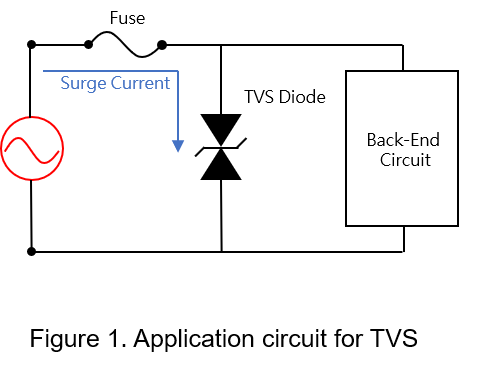
- Metal Oxide Varistor
Metal oxide varistor, calling MOV, also known as a surge absorber, is an electronic component with the properties of a non-ohmic conductor whose resistance changes by diffient external voltage. It is connected in parallel with the circuit that needs to be protected. When there is no instantaneous surge voltage, the MOV has a very high resistance value at both ends, so it does not affect the characteristics of the original circuit, but when the instantaneous surge voltage appears, the resistance of the MOV will be very low,closing to 0V, and the surge current will be shunted to achieve the role of protecting the circuit.
MOVs have a shorter life expectancy because that they will destroy the structure and reduce the threshold voltage, increase the leakage current after multiple shocks, and eventually lead to heating and failure. Therefore, fuse will be connected in series in use, as shown in Figure 2.
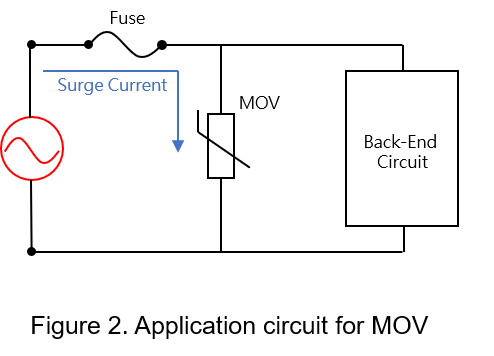
- Gas Discharge Tubes
Gas discharge tubes, calling GDT, is anti-surge voltage equipment in the most widely used a kind of protect element, and the principle is that when electrode voltage at both ends reaches to let the gas breakdown in the gas-discharge tube, it begins to discharge, and then the impedance at both ends of the gas-discharge tube becomes extremely small, so that the surge voltage is quickly shorted to the ground, and the back-end circuit is protected. The disadvantage is that the trigger time is too long and there is a freewheeling problem after conduction. Therefore, an additional auxiliary circuit is required to suppress the current, as shown in Figure 3. The fuse is used to prevent short circuit to cause excessive current.
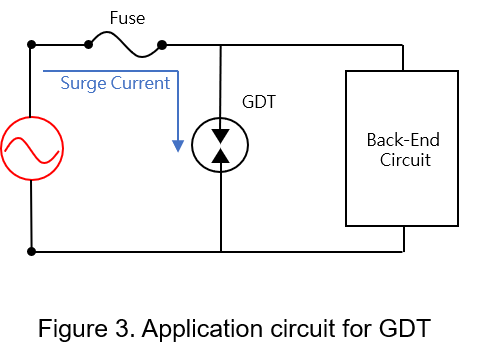
- LC Filter
LC filter circuits are often used to suppress of electromagnetic susceptibility through the frequency characteristics of capacitance and inductance, but it can be filtered by specifying the frequency and avoid the problem of high frequency transient voltage. If combined with other protection elements, surge voltage protection effect will be better. Figure 4 is a LC filter circuit. The larger the capacitance of a single capacitor in the filter, the greater the leakage current is occured, and if necessary, multiple capacitors can be connected in parallel to achieve the same effect.
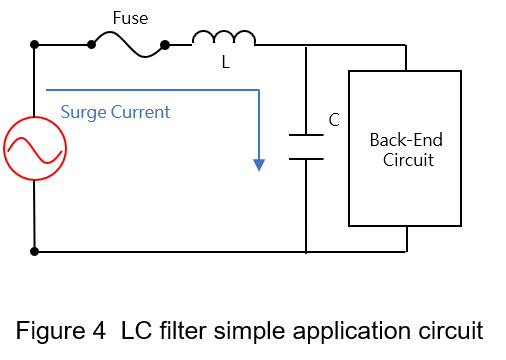
Arranging and comparing the above surge protection components, as shown in Table 2.
| TVS | MOV | GDT | LC filter | |
| Connection method | parallel | parallel | parallel | series |
| Reaction time | fast | middle | slow | - |
| Peak current | low | middle | high | - |
| Leakage current | low | middle | low | high |
| Breakdown voltage | low | low | high | - |
3. Composite Applications
If only a single protection component is used, protective effect cannot be work well, so it needs to combine with variety of different protection components in use to deal with different degrees of surge test level. Several common combinations will be described below.
- GDT and TVS
Since the reaction time of the ceramic gas discharge tube is slower, it may be too late to react when the transient surge happening. Hence, the surge energy may damage the back-end circuit. The use of coupling inductor as a buffer element to ensure that the ceramic gas discharge tube works first, and the residual surge energy is suppressed by the transient voltage suppression diode of the second protection to avoid damaging back-end circuit, as shown in Figure 5.
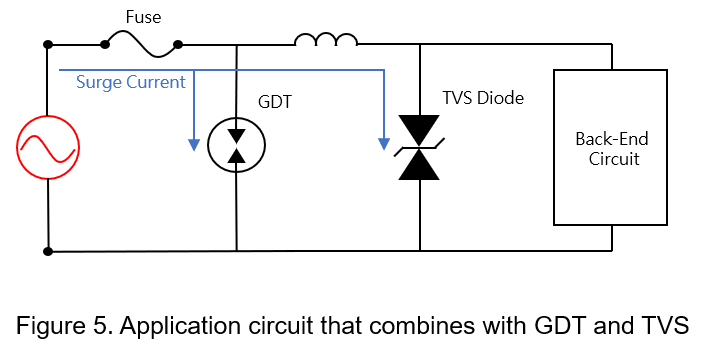
Due to the extremely low on-voltage of the ceramic gas discharge tube and the problem of freewheeling, it cannot be used directly in the AC power supply guard port. Therefore, it should be used in series such as a MOV and other components, as shown in Figure 6.
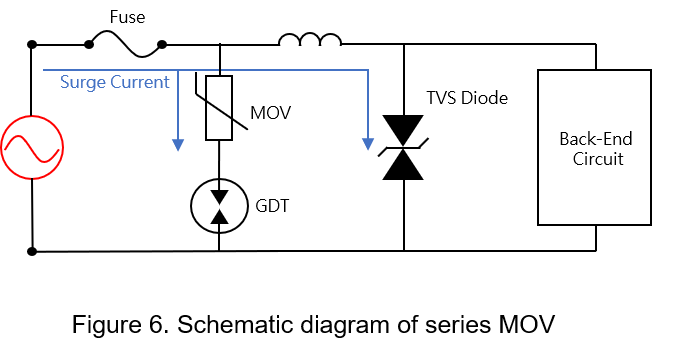
- MOV and TVS
Metal oxide varistor is more suitable for low transient voltages, as shown in Figure 7.
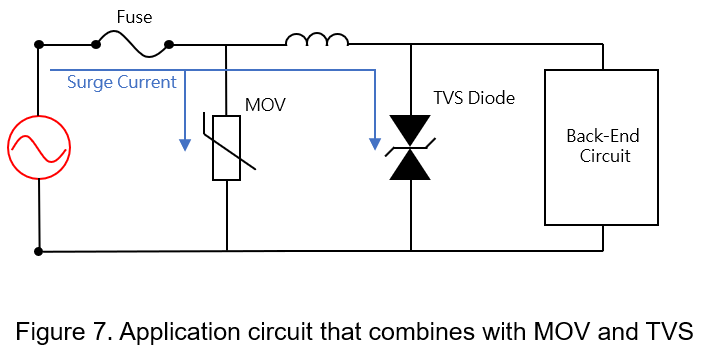
The capacitors are also connected in parallel to improve the ability of absorbing surge voltage, as shown in Figure 8.
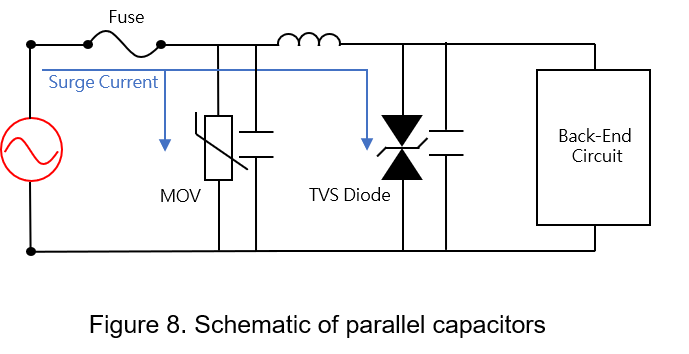
- TVS and LC filters
When the surge energy is low, a transient suppression diode can be used with an LC filter to not only more effectively mitigate output voltage variation, but also suppress low-frequency noise. The specific circuit as shown in Figure 9.
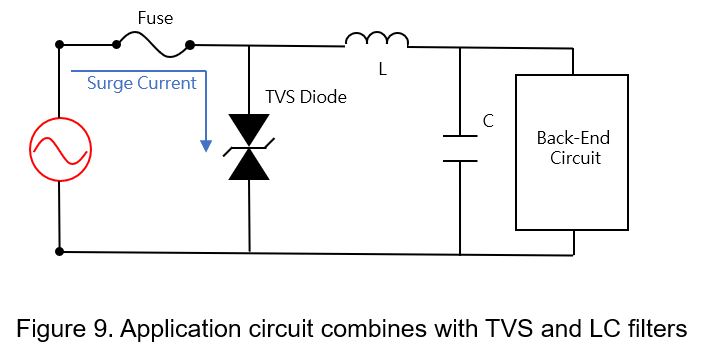
Conclusion
This article discusses several common surge protection components and provides a brief overview of how to work. A single protection component can’t completely protect the damage caused by the surge voltage. According to the characteristics of different protection components, a more complete protection circuit can be combined to pass the lightning strike withstand test standards of different voltages.
CTC is a professional service provider for high-end power supply modules (AC to DC Converter and DC to DC Converter) for critical applications worldwide since 30 years. Our core competence is to design and deliver products with leading technologies, competitive pricing, extremely flexible lead-time, global technical service and high-quality manufacturing (Made In Taiwan).
CTC is the only corporation certificated with ISO-9001, IATF-16949, ISO22613(IRIS), and ESD/ANSI-2020. We can 100% ensure not only the product, but also our workflow and service to match quality management system for every high-end application from the very beginning. From design to manufacturing and technical support, every single detail is operated under highest standard.

